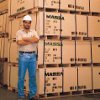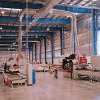Riding out recession
22 October 2003In hindsight, Masisa SA could not have picked a worse moment in late 2001 to start up a second MDF production line of 120,000m3/year in Argentina.
The Chilean panel maker originally launched its Valmet thin MDF continuous line to serve the local markets of Argentina and its Mercosur free trade partners, Paraguay, Uruguay and Brazil. But, with recessionary Argentina plunging headlong into its worst ever political and economic crisis, and panel over-supply and political uncertainty dogging the Brazilian market, Masisa Argentina SA was forced to rely heavily on exports further afield.
“The national economy just stopped. We had to make a lot of effort to continue working at the Concordia plant and needed to make more effort to export,recalled Masisa Argentina’s managing director Jaime Valenzuela.
Devaluation of the Argentine peso, the fall of the government and bank closures devastated the domestic economy. Construction halted and, in 2002, the bottom dropped out of the wood panel market leaving MDF capacity of 550,000m3/yr chasing a tiny home market of barely 60,000m3/yr, confirmed Mr Valenzuela.
Masisa’s Argentine subsidiary operates a major panels complex at Concordia. In 1995, it launched its first MDF line, a 120,000m3/yr Sunds/Dieffenbacher continuous line, now with a 150,000m3/yr capacity. Apart from that, the site runs a 160,000m3/yr single-opening Bison press particleboard line, along with a 25,000m3/yr thin board Mende line.
In the months since the Argentine crisis hit, Buenos Aires-based Masisa Argentina has seen its business turned upside down. From a pre-crisis trade balance of 30% export to 70% domestic sales, it can hardly sell 30% at home today, with the rest disposed of at low prices as far afield as Asia, the US and Europe.
Problems in South America’s ‘southern cone’ nations have been compounded by the lingering world recession and global uncertainty in the run-up to the Iraq War.
Margins were slashed as the company’s Concordia mill continued to pump out both MDF and particleboard. Government export incentives have been cancelled out by high freight costs and escalating customs tariffs. “As you know, this [panels] is a commodity and it is not easy to sell abroad – especially particleboard. It’s not common to export particleboard and often we had to export without margins, only to continue working at the mill,admitted the managing director speaking in Buenos Aires earlier this year.
Masisa Argentina was forced to reorganise its operations and cut costs, which included lowering the pay bill. This took the form of axing some of its top managers: higher paid Chilean staff and skilled technicians.
Faced with low demand, shrinking margins and ever tighter competition at home and abroad, the panel manufacturer has had to come to terms with its competitors rather than enter a fruitless price war.
“In the end, you try to survive. You try to compete, but we are not being stupid. If you try to get their [other players’] business and [to] lower prices, they are only going to do the same to you,said Mr Valenzuela.
His company has not only had to reach a truce with its traditional opponents, but faces the prospect of new pressure with the arrival of a powerful new player.
Last July, Chilean forest products giant Arauco launched its 250,000m3/yr MDF plant in northern Argentina and is now deciding whether to install a second line at the Puerto Piray site.
Masisa Argentina saw the culmination of its US$28m MDF II expansion project in November 2001, when the new Metso-supplied thin board unit, with a 2.6m wide Küsters continuous press, started up.
While its arrival came at a tough time in market terms, it also introduced an attractive new product to the producer’s portfolio. Thin MDF in a 2.5mm to 9mm range, has proved a good export product and, in March, the line was nearing full production.
“Thin MDF has a good market. It was a good idea to focus on that product. The line is running at about 8,000m3/month right now and we want to run it at full capacity,confirmed Martin Buffa, head of the Concordia mill’s melamine lamination section.
Prior to the launch of MDF II, the first line was increasingly turning out thin board, which represented around a third of its annual production in the year before the new line came on stream.
Furnish for the new line, now dedicated to thin MDF, is a mix of ‘elliottii’ pine and eucalypt, the latter used more than in raw material for thicker board manufactured on MDF I at Concordia. While the use of eucalypt tends to darken the board finish, it also represents a solid saving in wood cost.
Concordia’s MDF I line, which produces the thicker range of pine based board, maintained full production throughout last year, despite the lingering crisis. The two lines consume around 190,000 tonnes of wood a year, much of it brought by rail from northern Argentina’s Corrientes province, up to 400km away.
Masisa recognises the way forward must involve adding value to its commodity products. It has reacted quickly to the tough market conditions with several new projects to increase the value of its end products.
In its latest move, the firm entered the lucrative MDF mouldings business in January 2003, adding a 3,800m3/month mouldings plant. It is equipped with a ripsaw, two Weining moulding machines, two paint lines and a packaging unit, and uses 9mm to 13mm board from MDF I.
The mouldings plant is labour intensive and already has a team of 50 manning two shifts to meet growing demand, in particular, from export business in the US.
“Three months after starting up the plant, we have begun exporting and the lines have been very successful. Output has reached 2,000m3/month. In September, we expect to be at full capacity,enthused Mr Valenzuela.
Masisa Argentina can turn out a range of some 40 mouldings for floors, doors, ceilings and furniture with its new plant, which will require four shifts when running fully.
“The US mouldings market is growing well. At the moment, we have no problem in putting our product in the market there,added Mr Buffa. Around 90% of the mouldings is destined for the US. There is room for expansion beyond current capacity should demand require it, according to Mr Buffa.
The Concordia site is already equipped with two Wemhöner low pressure melamine laminating lines and a double Vits overlay paper impregnation line. In December 2001, Masisa Argentina launched a new 50,000m3/yr Barberan finish foil unit. Prior to its arrival, Masisa produced finish foil panels using a melamine press line. The new addition has helped to save production costs, explained Mr Buffa.
But, today, demand for laminated board is still limited to Argentina and its Mercosur neighbours. At the end of March this year, the melamine lines were operating at around half their 200,000m3/yr capacity, more than 60% of that covering particleboard. The finish foil line is used to cover mainly thin panels from the Mende particleboard line (4mm) and a small amount (3mm) from the MDF II line. To date, demand has limited production to around a quarter of capacity.
The Concordia plant supplies the Brazilian market with some of the line’s output via local offshoot Masisa do Brasil SA. It produces MDF and OSB panels, but has no finish foil facility.
It is clear that Masisa Argentina will need to invest further as it grows its business and develops more value added projects at Concordia. But the Masisa group has entered a phase of consolidation and cost saving. Since it was acquired from its owner, Inversiones Pathfinder Chile SA, by the leading Chilean forestry company Forestal Terranova in July 2002, its operations have come under the financial microscope.
Nowhere has the new owner’s scrutiny been more intense than over Masisa Argentina, which accounted for a large slice of Pathfinder’s regional investment in recent years. Now, it feels, it is payback time.
“Masisa came to Argentina 10 years ago with an objective of investing US$35m here. In the event, we have invested more than US$300m. But now it is very difficult to say to shareholders: ‘Invest here!’ Nobody’s going to put money here if they do not see changes,admitted Mr Valenzuela. The new mouldings line represents the final investment agreed for Concordia by Pathfinder.
What is clear is that the new owners want to see decreasing costs, a halt to losses, and some return on Masisa’s huge investments in Argentina. There are signs of recovery there, particularly since May when a new president took over in Argentina. Demand has improved and prices have stabilised somewhat, but Masisa still forecasts tough times ahead for a year or so.


